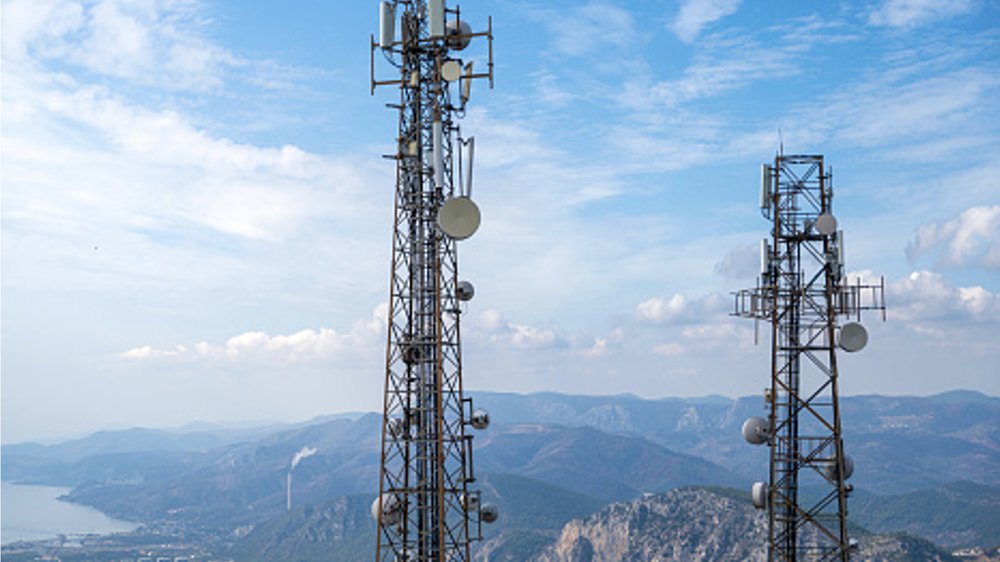Broadband leadership at the state level barely existed ten years ago. Now, states are in the hot seat, tasked with a crucial role in brightening the economic future, not only of the internet-deficient rural areas that will need state broadband grants to catch up with the 21st century, but of the whole United States. For success in that critical job, a little economics will go a long way.
On May 13, the federal government announced the rules for the huge broadband infrastructure and digital equity grants authorized by the Bipartisan Infrastructure Law. Key deadlines, such as July 12 to apply for digital equity planning grants, July 18 to send a letter of intent to participate in the infrastructure grants, and August 15 to apply for infrastructure planning funds, are fast approaching. The objective is to get every American online and empowered to thrive in a digital world. Expectations are high. Can state broadband offices rise to the challenge?
States are tasked with this daunting job because of a major pivot in federal broadband policy. Five years ago, federal broadband subsidies were mostly channeled through the Federal Communications Commission (FCC), with the US Department of Agriculture playing second fiddle. The subsidies were supposed to solve the problem of poor connectivity in much of rural and small-town America where monopolistic internet service providers used obsolescent technologies to provide internet service at speeds a fraction what was offered in cities and inadequate to meet the needs of modern internet users. But the FCC let big telecoms underinvest, and states got discontented. They began to stand up broadband offices and broadband grant programs of their own, using scarce state funds at first. Pressure built for a policy overhaul.
And so, when pandemic response spurred a federal broadband funding surge, Congress leaned on the states to take the lead. The CARES Act, in 2020, gave each state at least $1.25 billion of discretionary “coronavirus relief” funds, for which emerging guidance soon established broadband as one allowable use. Then in January 2021, the American Rescue Plan gave more money to states; this time including $10 billion (nationally) earmarked for infrastructure, with an emphasis on broadband. And then, in November 2021, the Infrastructure Investment and Jobs Act (IIJA) allocated $42.5 billion—none has been spent yet—to the states for broadband, this time accompanied by a mandate to bring broadband service to all serviceable locations at fast speeds of at least 100 Mbps download, 20 Mbps upload. It’s up to state broadband leaders, under federal supervision through the National Telecommunications and Information Administration (NTIA), to achieve that.
If state broadband leaders do their jobs well, they can expand the effective housing stock (since dwellings without internet access are unlivable for the vast majority of the population that now needs connectivity), make farming more productive and environmentally friendly, and light up some of America’s worst poverty traps with opportunity. If they trip up, a lot of federal deficit spending will simply pad monopoly profits or get sunk in boondoggles, and areas will get left behind, withering away on the wrong side of the Digital Divide. The stakes are high.
Some old, versatile ideas from economics can help state broadband offices figure out how to put all that money to good use.
Demand for Internet Service Slopes Down
First, it helps to think about internet service customers as comprising a demand curve, like this:
Figure 1: Demand for broadband slopes down
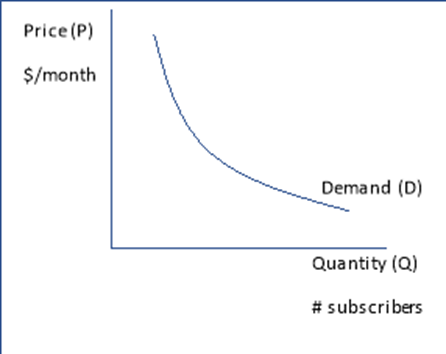
The demand curve is drawn in an abstract space of two dimensions, representing price and quantity. It slopes down, indicating that when prices are high, people buy less, and when prices are low, people buy more. So, one lesson from the demand curve is that internet service providers (ISPs) can’t just charge whatever they want, even when people have few or no alternatives in the area. If the price charged for internet service is too exorbitant, people will resort to cellular or satellite internet service or simply go without, painful as that is.
It Takes a Critical Mass of Demand to Make the Business Case for Deployment Work
That brings us to one explanation for the cause of the Digital Divide, which is that in some areas, not enough customer revenue can be generated to cover the costs of building and maintaining the networks. We can display this situation in a chart, with the help of an additional curve called average cost, like this:
Figure 2: In some places, broadband is too expensive to deploy without subsidies
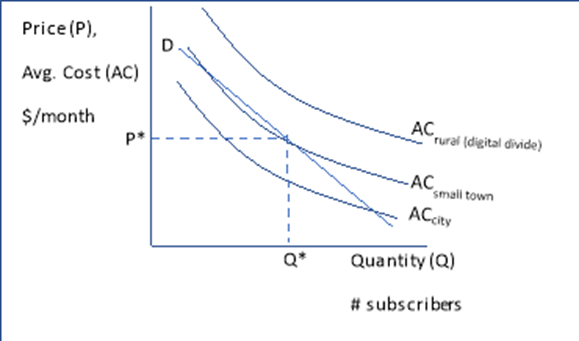
Average cost means the total cost of deploying the network and serving subscribers divided by the number of subscribers. Like demand, average cost generally slopes down, but for a different reason. Namely, most enterprises involve some “overhead” costs that must be incurred regardless of the scale of operations. More subscribers means that overhead costs can be shared across more customers, reducing average cost.
The chart shows three versions of the average cost curve. ACcity represents the average cost to deploy in an urban area. Houses are close together, so a length of fiber or a communication tower can serve a lot of people, keeping average cost low. ACsmall town is higher because small towns have fewer people and tend to be less concentrated. But in this example, it’s still possible for an ISP to cover expenses with customer revenues if they charge a price like P*.
But many rural areas are in the situation represented by ACrural, where the average cost of deployment is higher than an ISP could possibly get from customer revenues, regardless of how much they charge or how high a take rate they achieve. As they say in the industry, “there’s no business case” to deploy to an area like that. Ideally, broadband grants help “close the business case” for delivering broadband service to places that wouldn’t otherwise get it. However, sometimes they probably just pad ISP profit margins. State broadband offices face the delicate task of achieving universal broadband access while minimizing windfalls for ISP shareholders.
The Choice of Technology
State broadband leaders will also have a lot of influence over what technologies are used to serve rural America. The main technologies in play are fiber and fixed wireless.
Fiber optic cables, with ultra-pure glass inside, have extremely high capacity to carry data at the speed of light and are considered “future proof,” able to meet all the needs for ultra-fast connectivity that technologists can foresee. But fiber must be buried in trenches or strung between utility poles, and that’s expensive.
Fixed wireless ISPs shoot a signal from a tower to antennas on people’s homes. The airwaves can’t match the capacity of fiber, but they’re cheaper, so fixed wireless is usually a less capital-intensive way to meet rural America’s broadband needs. So, what should be done?
This is getting subtle, so it’s time for another graph.
Figure 3: Choice of technology, fixed wireless vs. fiber
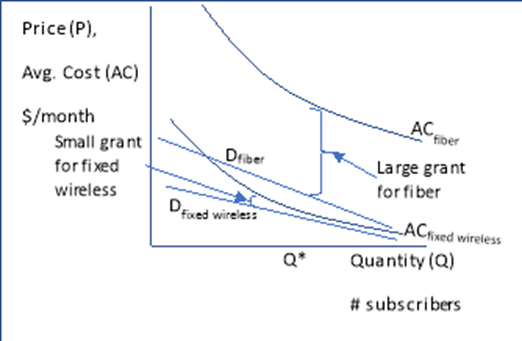
This time there are two demand curves and two average cost curves, one each for the rival technologies of fiber and fixed wireless. The area described by the chart is evidently one of those where “there is no business case” to deploy broadband without subsidies, since both average cost curves are above both demand curves. The demand curve for fiber is a bit higher. Fiber is better internet service, so there’s a bit more willingness to pay but not much more since fixed wireless can meet the need too. Meanwhile, average cost for the fiber deployment is much higher.
Either deployment, in this scenario, will require a broadband grant, and state broadband leaders should provide one to achieve the IIJA’s goal of universal broadband service. But which project should be executed? Depending on how state broadband leaders make the rules, either a fiber or a fixed wireless provider might win.
The key takeaway from the chart is that the fiber project will require a much bigger grant to make it happen. The fiber provider can get more revenue from customers and so might be willing to put more financial “skin in the game.” But costs are so much higher that it still needs a much larger grant to deploy. High-quality fiber deployments to remote, thinly inhabited places can be wasteful. For example, if a broadband project is so expensive that it would be cheaper to buy all the served homes outright at a price advantageous to their current owners, that project shouldn’t happen.
The National Productivity Payoff
Meanwhile, urban and suburban taxpayers with good internet service may wonder what’s in it for them. Hopefully, digitally well-connected people won’t mind seeing their tax dollars rescue the digitally disadvantaged from their plight, but they might feel some regret if that will make the rest of us a little bit poorer from subsidizing all these high-cost rural broadband deployments. Will it?
Actually, maybe not. Here’s another chart (not for the faint of heart) to show why.
There is a secondary vertical axis and a distinction between green curves, measured against the primary vertical axis on the left, and red curves, measured against the secondary vertical axis on the right. The green curves are the familiar demand and average cost curves. This is another area where average cost is higher than demand, so there is no business case for deployment without subsidies. But the red curves show total amounts: total cost, total revenue, and, most subtly, total benefit.
Figure 4: Broadband subsidies can enrich the economy when total benefits exceed total costs
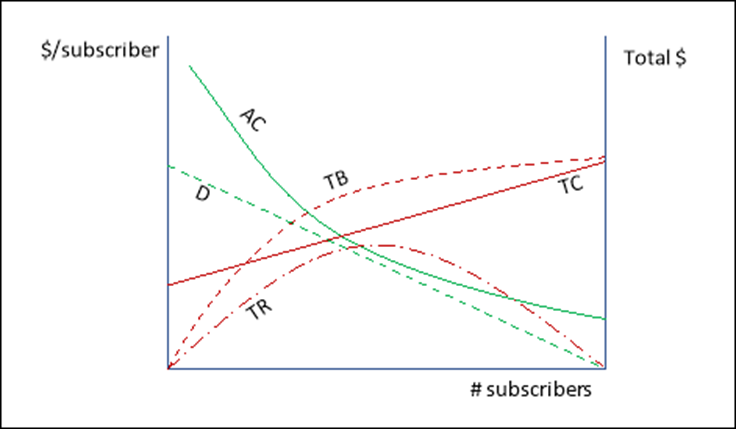
The total benefit curve represents cumulative willingness to pay. The fact that total benefit rises above total cost indicates that, if people in the area described could somehow be induced to pay to an ISP the full value of what the internet service is worth to them, then the ISP could cover its costs of deployment without subsidies. But the ISP can’t price discriminate like that, so it won’t build.
Many rural areas in the US probably find themselves stuck in this kind of coordination problem, where residents with high and low willingness to pay can’t get what they want because networks can’t avoid charging them the same price. If the price is high, some residents won’t subscribe. If it’s low, high-value customers won’t simply offer to pay extra. Either way, the ISP loses potential revenue and can’t cover its costs.
Rather than helping locals to find subtle solutions for this coordination failure, the feds are just throwing money at the problem, via state broadband leaders. Yet that should work, and, in principle, it can create value, in the form of quality of life and economic productivity, that exceeds the cost, contributing a nice productivity boost for the US economy as a whole. The benefit will start out as a windfall for digitally backward rural areas, but the economy has a lot of ways to spread the wealth from productivity gains around.
Concretely, how might an urban or suburban taxpayer benefit from well-spent rural broadband subsidies?
She might sell her urban home, move to a newly-wired rural place, and telework, while pocketing the difference in house prices and enjoying more space and greenery.
Or, she might benefit as a renter, aspiring to buy but thwarted by the housing shortage until other people, probably teleworkers, move out of town to newly-wired country homes and free up affordable inventory in metropolitan housing markets.
Then again, she might stay put but be running a business that is hurting for workers. Rural broadband expansion will open up new possibilities for urban firms to outsource back-office work to telecommuters in newly-wired rural areas.
Or yet again, she might benefit as an online shopper, newly able to order from rural small businesses just getting online. Or she might find cheaper, higher-quality products on the grocery store shelves as broadband investments unlock the potential of precision agriculture. She might be a teacher and find that she can embrace tech-savvy 21st century teaching methods as the IIJA’s push for universal broadband access eliminates the problem of students lacking home broadband. Or she might be a parent, with good home internet access for her own kids, but see classroom instruction improve with the use of more technology as other kids get online.
Ten years from now, the nation may be thanking state broadband leaders for the key role they played in upgrading the national economy. For now, though, state broadband offices will struggle to rise to the challenge. Some talented people might want to consider a career change into state broadband leadership right now. It’s a great opportunity to make a difference.
And state broadband leaders need to keep their economic thinking caps on.
About the author
Nathan Smith is a Broadband Policy Specialist with Connected Nation, a national nonprofit working to close the Digital Divide for all people in the US. Previously, Nathan led the Arkansas State Broadband Office and developed and administered the Arkansas Rural Connect broadband grant program, which allocated roughly $100 million in federal coronavirus aid to connect tens of thousands of Arkansan households to the internet during the early pandemic lockdowns. Among other writings, his PhD dissertation, “Complexity, Competition and Growth,” explores the economic theory of technological change.

